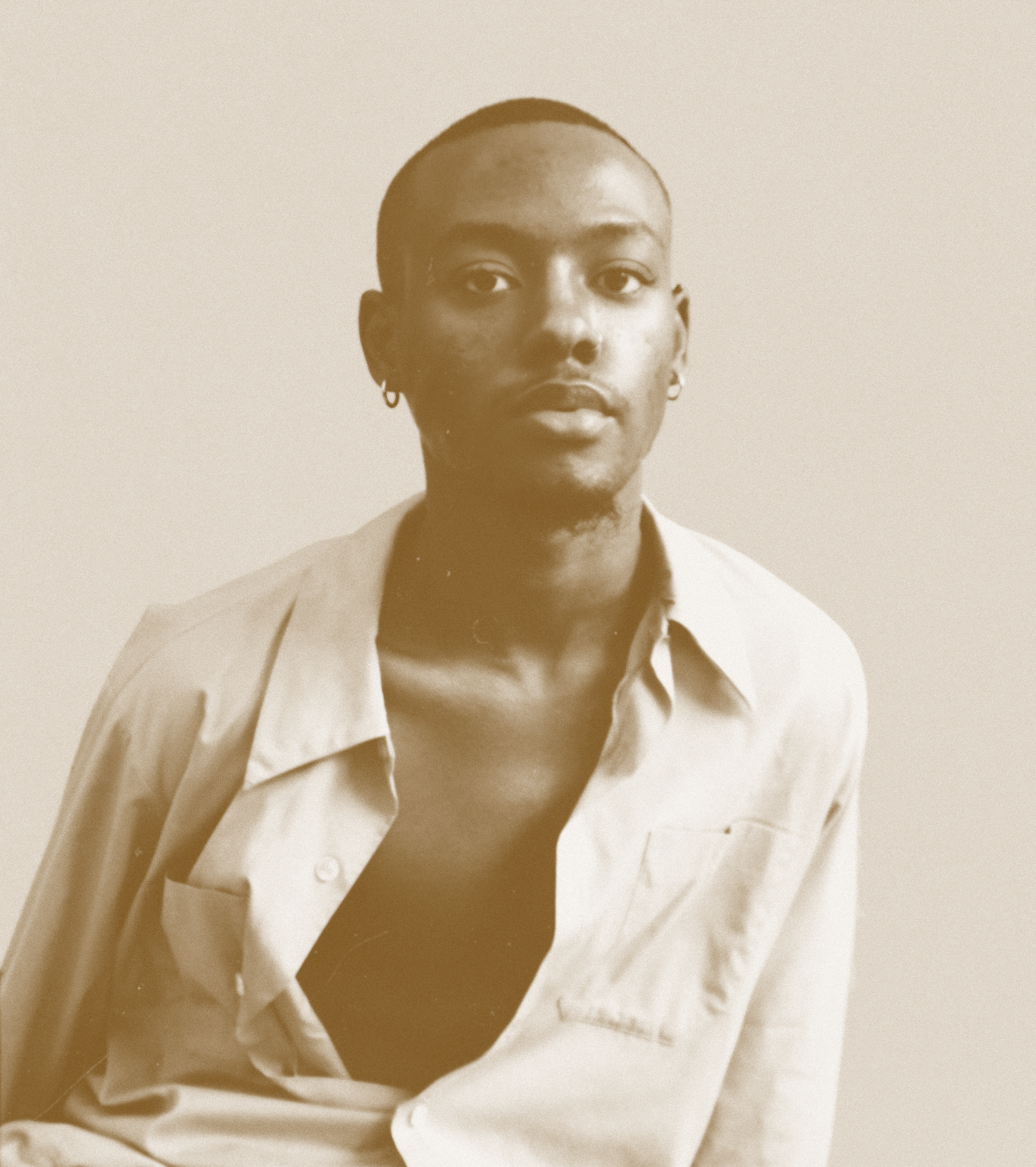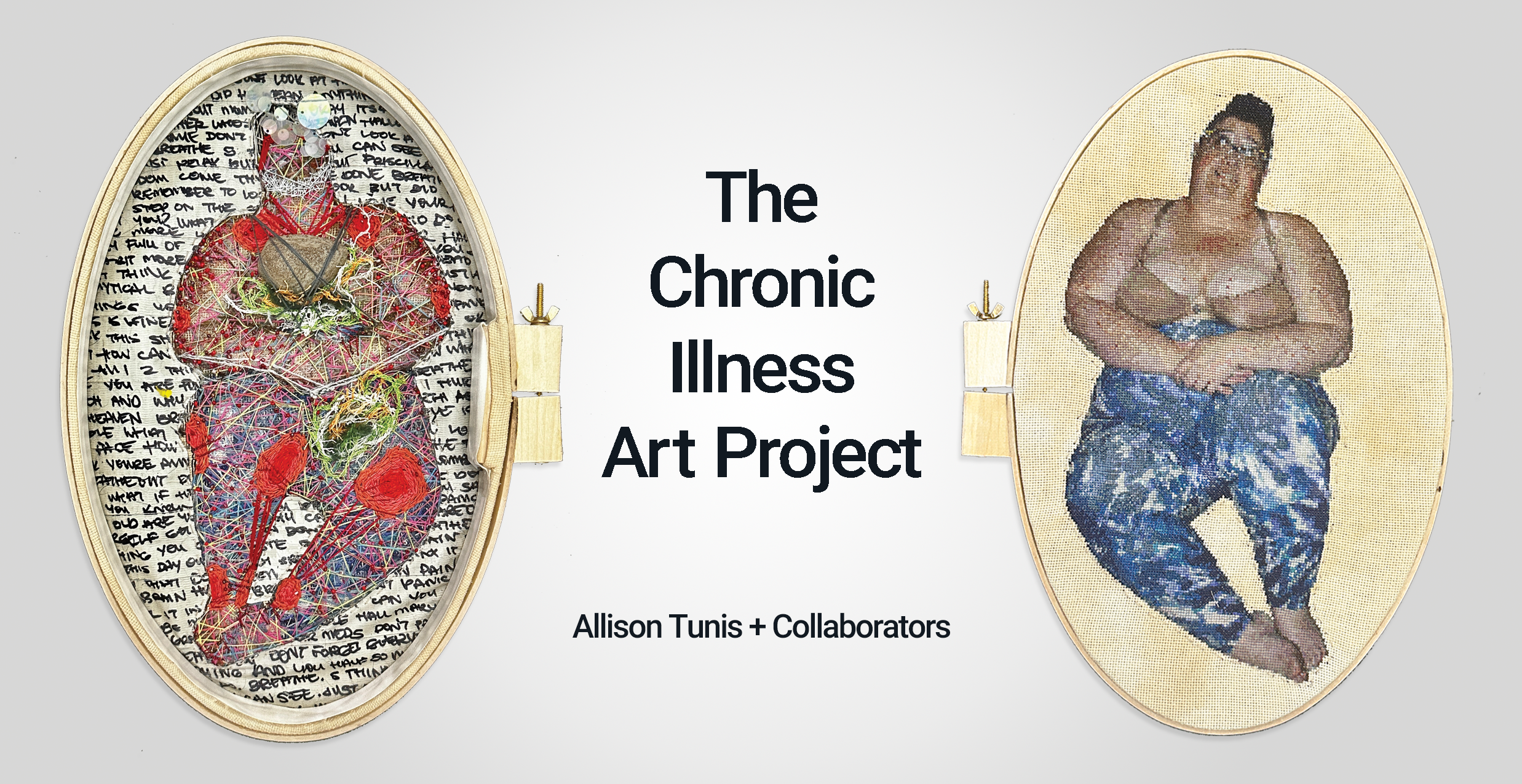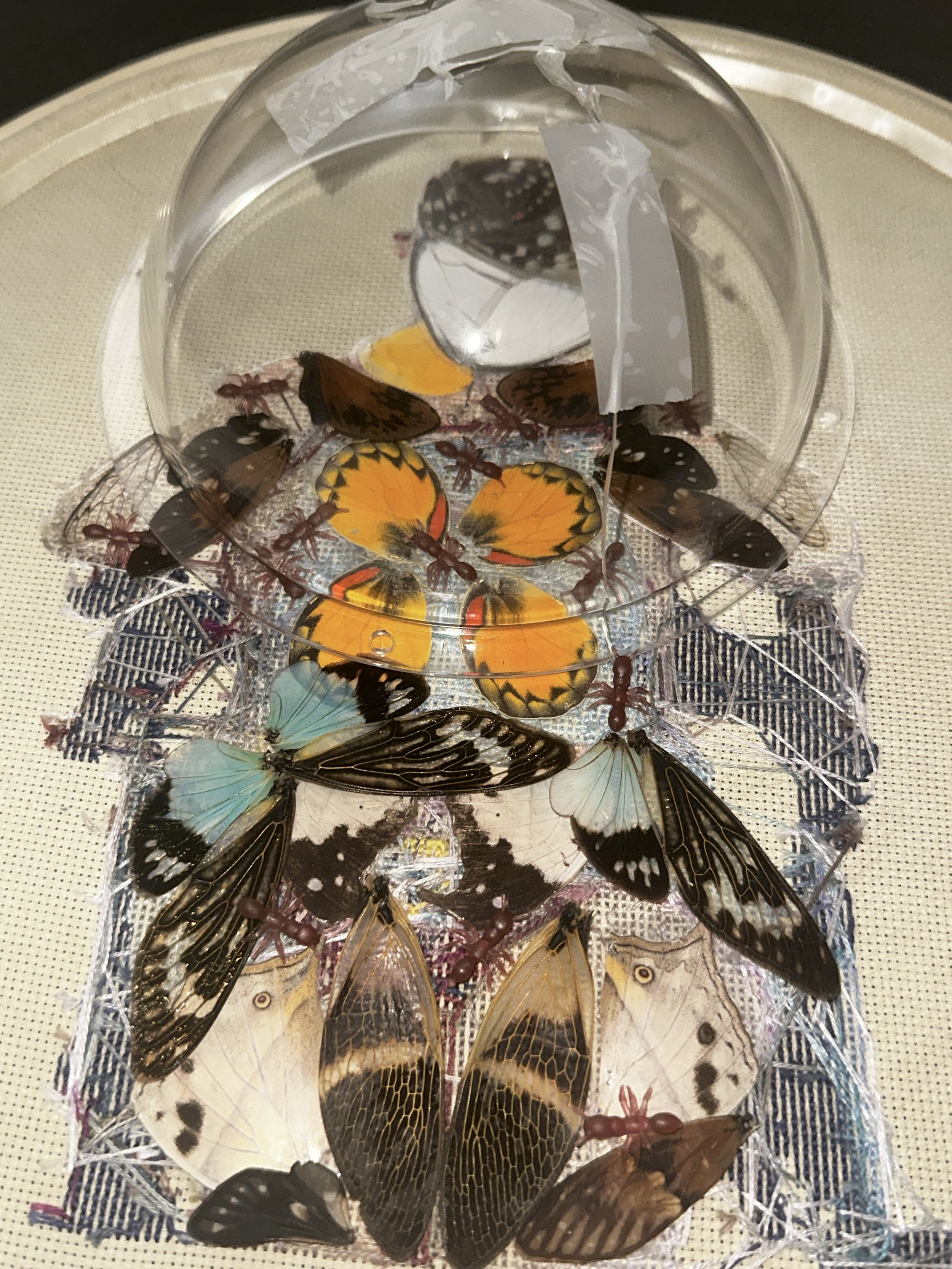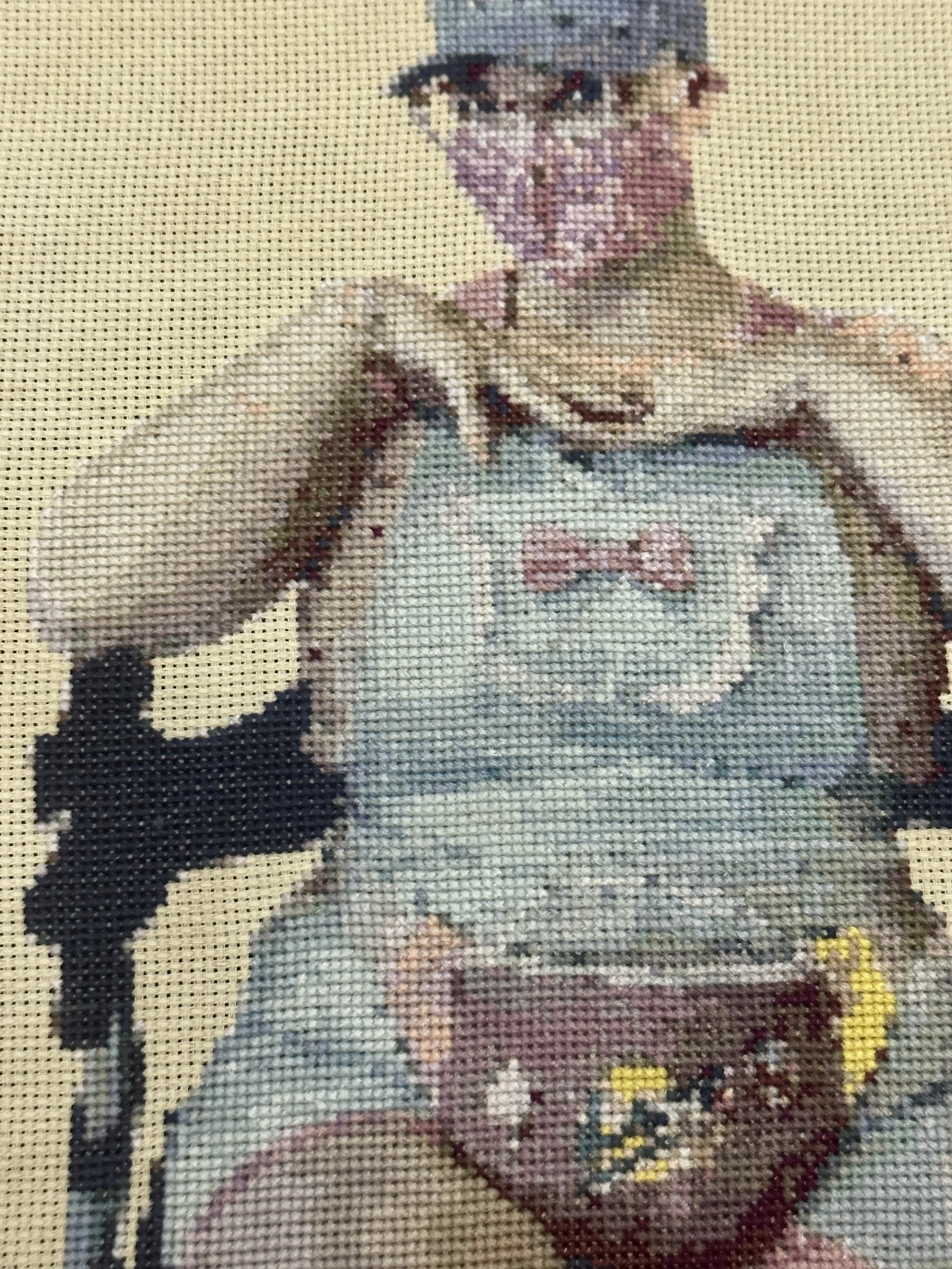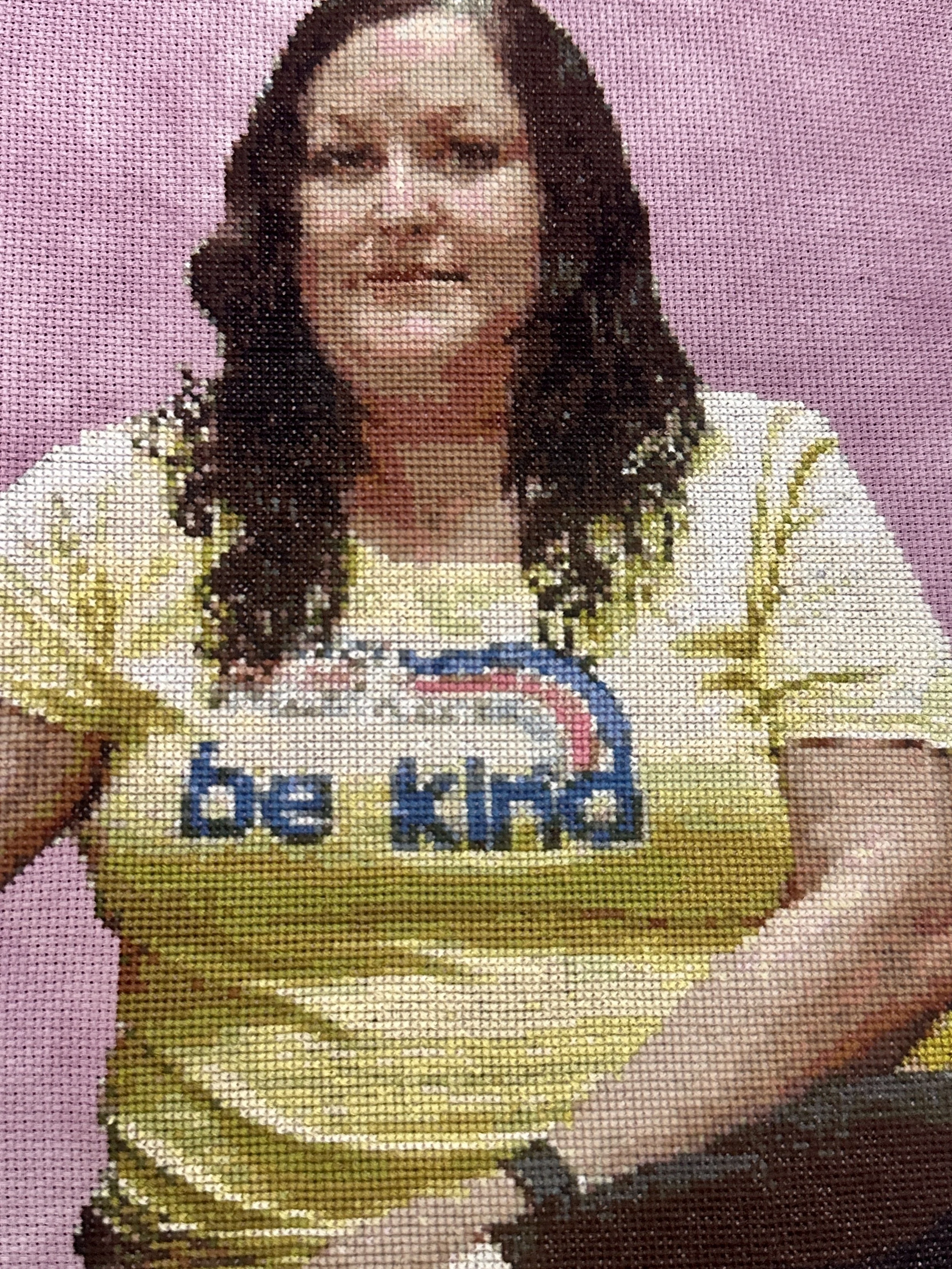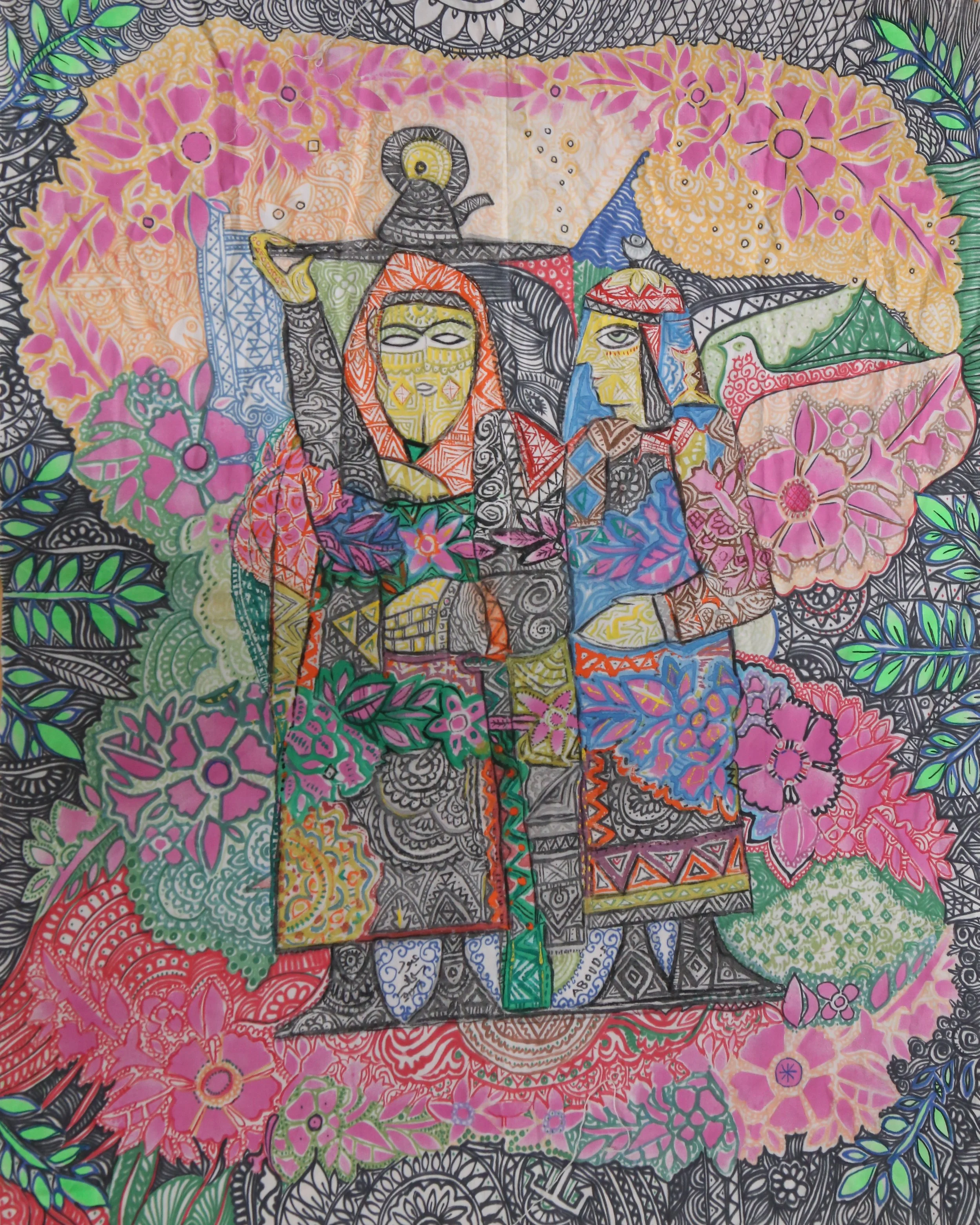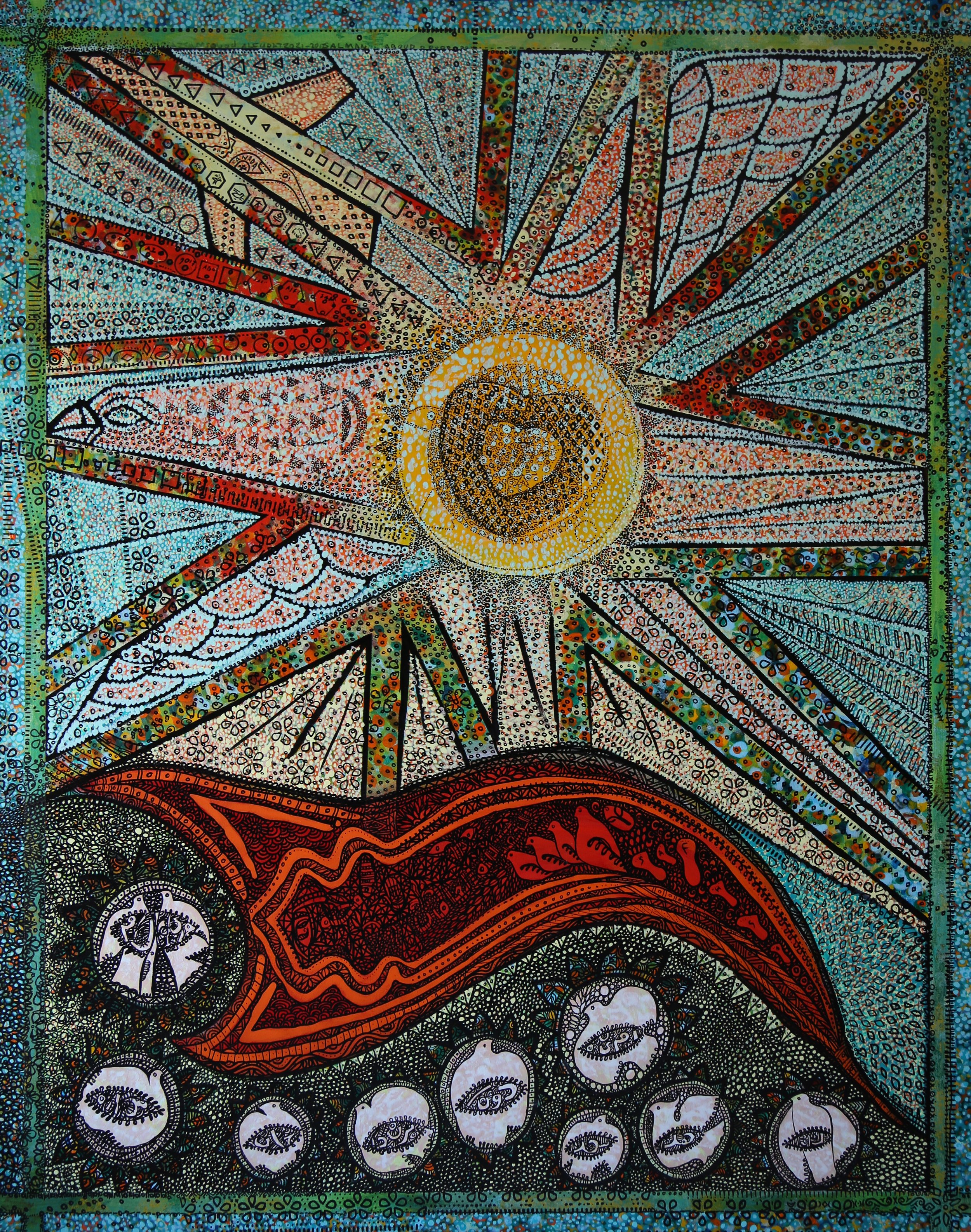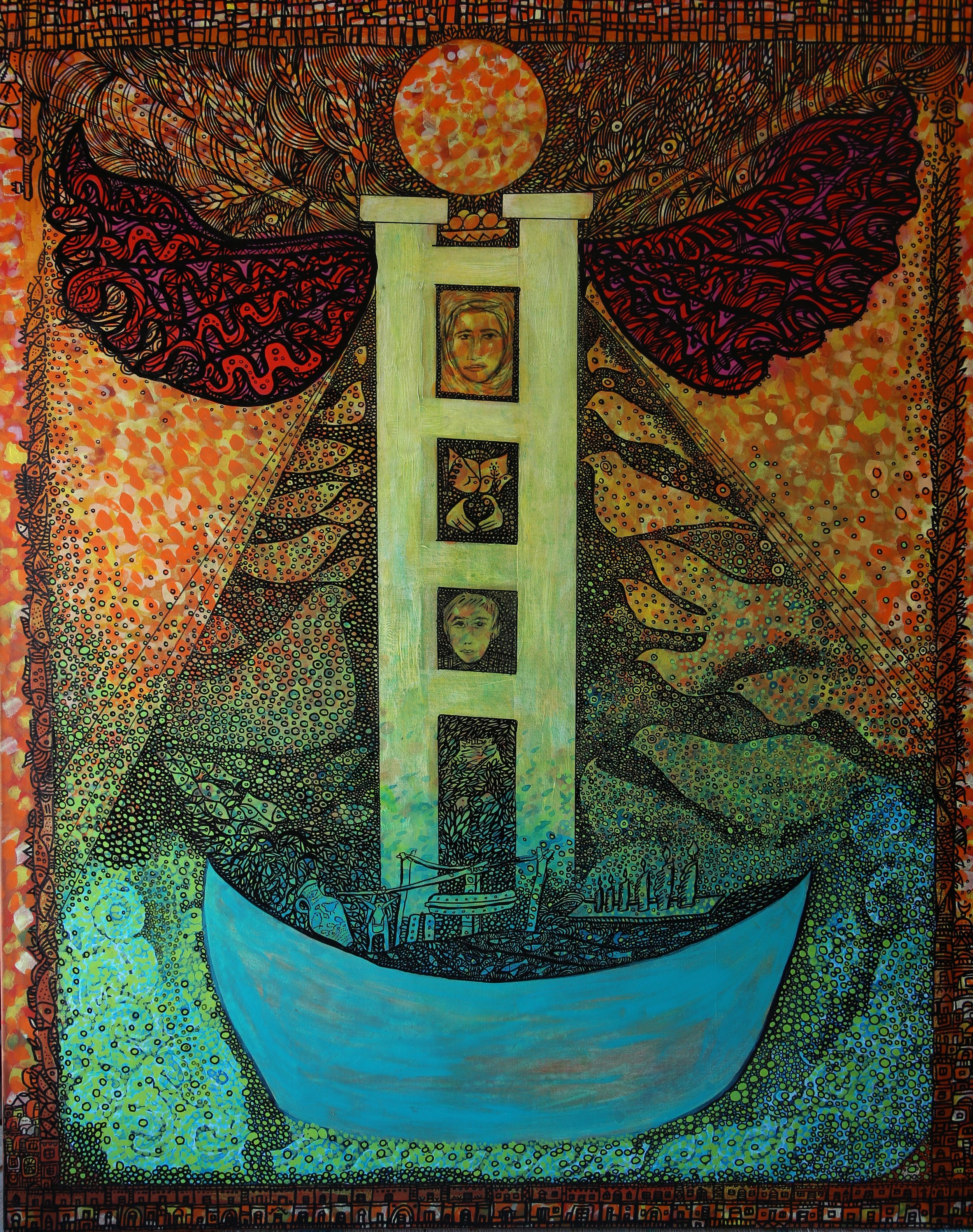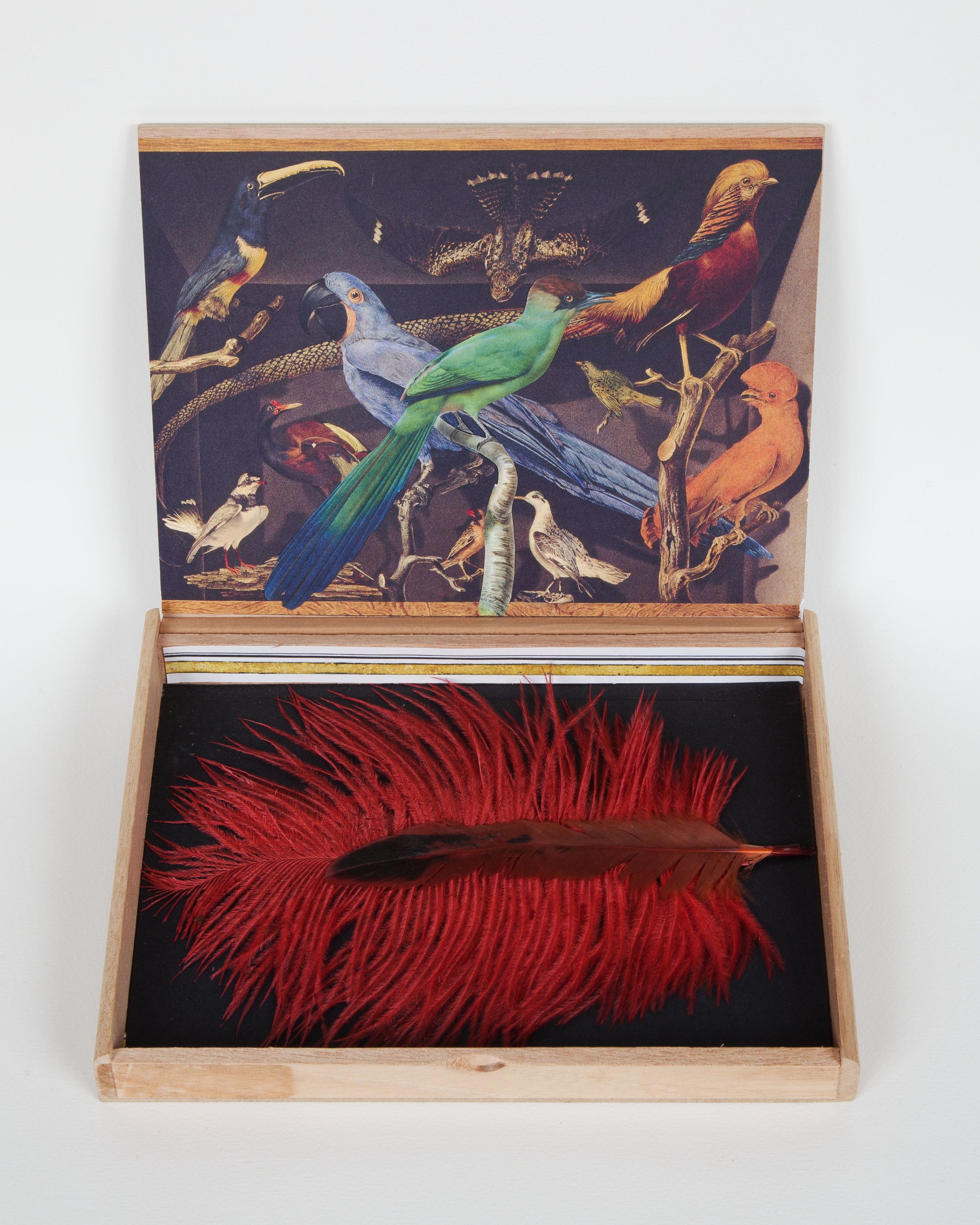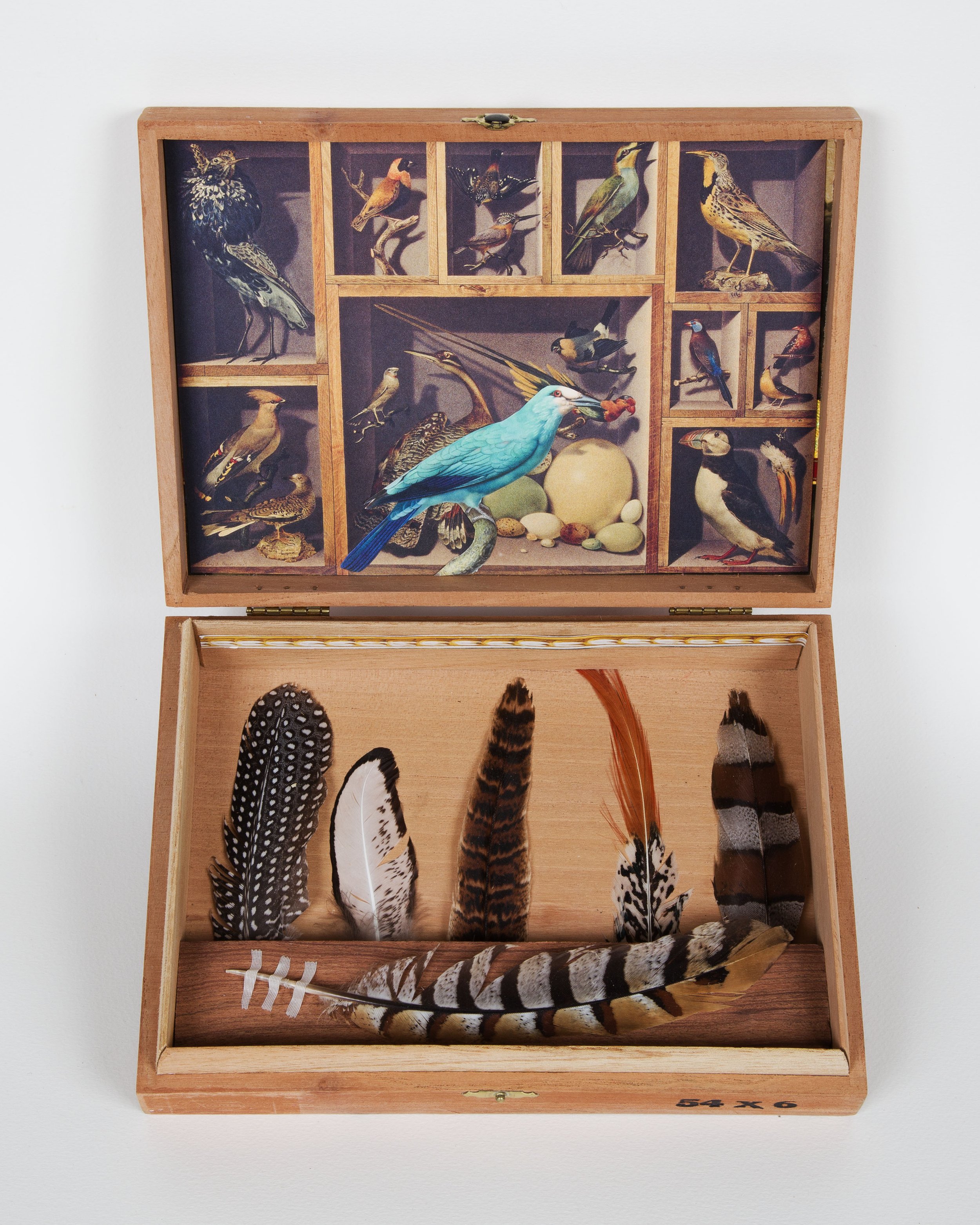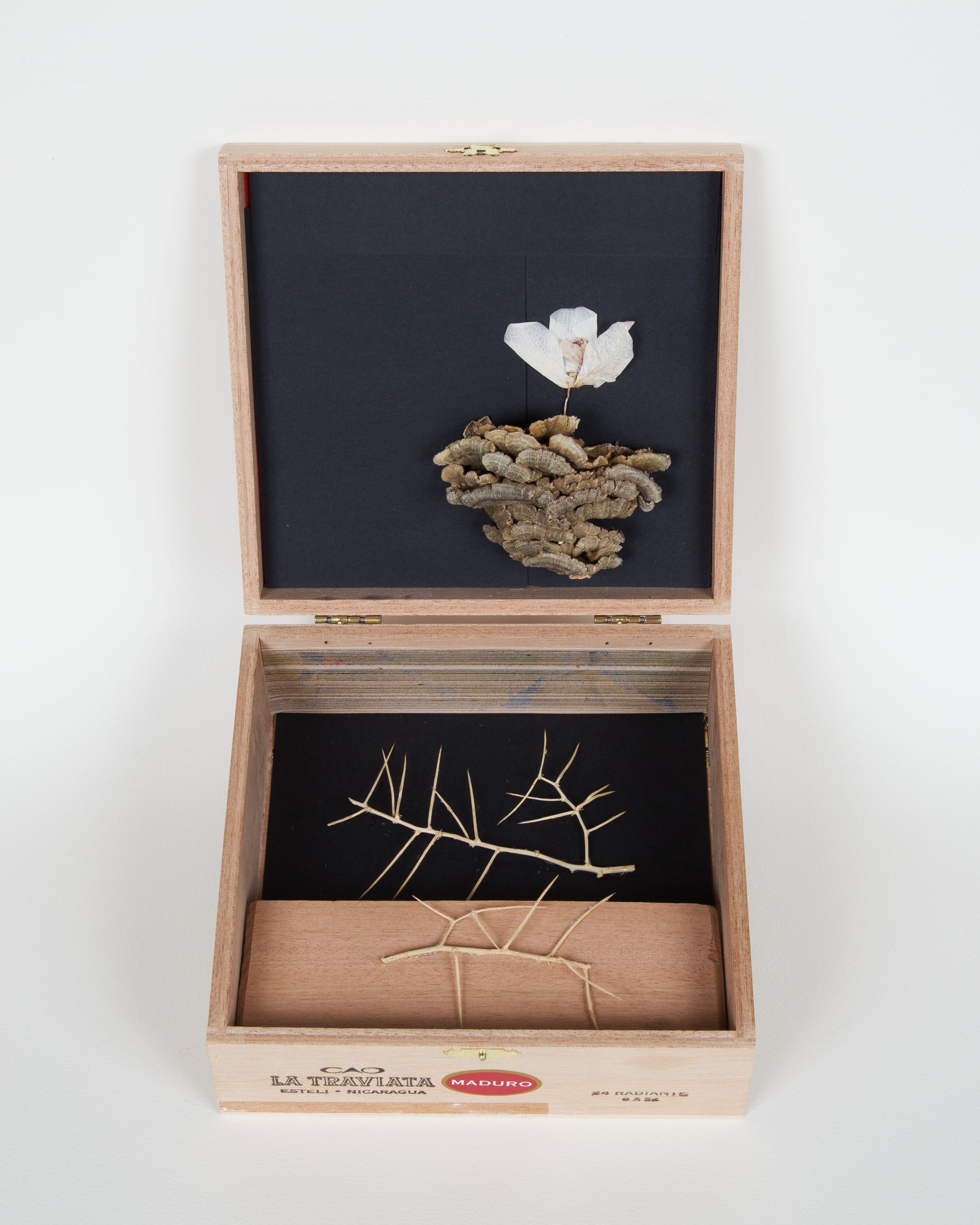Cui Jinzhe’s exhibition Om ~ Ah ~ Home:Healing Space for Body & Mind, is a poetic journey of finding grounding between the two worlds Jinzhe calls home: Dalian, China, and Edmonton, Alberta. Her work takes the form of three bodies of work, including a painting series, an interactive screen panel installation, and a kinetic mixed media and ceramics sculpture.
Read moreShadow Bloom - Elisabeth Belliveau + Darrell Spearman
Shadow Bloom
Elisabeth Belliveau + Darrell Spearman
Shadow Bloom explores the delicate interplay between light and darkness, growth and stillness, through the works of artists Elisabeth Belliveau and Darrell Spearman. It asks what life becomes when we delight in subtle moments rather than conventional notions of success—when we honor growth even when it seems invisible and intangible, like the quiet yet profound transformations embodied in flowers that emerge, evolve, and reshape their surrounding landscape.
Belliveau's kinetic sculptures manifest as abstract mother(ing) forms that transcend traditional identities. Her suspended mobiles and tabletop pieces embody the rhythms of caring, resting, playing, and maintaining balance. Drawing inspiration from formalist sculpture, Ikebana flower arranging, and her experiences of motherhood, Belliveau collaborates with her two-year-old son to create works that engage children and adults alike in contemporary abstract art through processes of balance, play, and material experimentation.
In conversation with these sculptural forms, Spearman's poetry offers moments of quiet contemplation. As a multidisciplinary artist from Brooklyn practicing writing and dance, Spearman uses flora as metaphors to confront and comfort difficult feelings, honoring the process of unraveling. His collected poems explore change—its complexities, pain, healing, and beautiful simplicities—like the weeds, thorns, buds, and blooms that inhabit gardens.
Both artists observe power in moments of hope, balance, and playfulness. Their work exists in the tension between positive and negative space, between light and shadow. Through this exhibition, they invite us to pay attention to the unseeable, to offer compassion to ourselves and others, and to slip into tenderness.
Selected Images - Elisabeth Belliveau
Artists on The Wards: "For Artists on 'Not Artists'"
October 15 - December 1, 2024
When we walk onto your unit, or into your hospital room, we don’t want to put you to work by making you paint or clap your hands to a song. We want to learn who you are beyond ‘patient’. It’s okay if you are ‘not an artist’, we know you have interests and passions that can engage and inspire you. Though we are not ‘art therapists’, what we offer is therapeutic. Research continues to show that engaging in, or even chatting about, creative interests can have a lot of different benefits.
As an embedded artist/researcher and Psychiatry graduate student, I curated this exhibition of both staff and patient work relating to the diverse ways that the Artists on the Wards engage the University of Alberta Hospital community, and have done so for 25 years.
-Jennie Vegt
What We Carry 唐人街 - Curated by Jordon Hon 韓寶軒 and Shawn Tse 謝兆龍
August 19 - October 4, 2024
Closing Reception: Friday, October 4, 7-9pm
How does art play a role in the evolution of our cultural spaces?
We often think of Chinatowns as places to preserve and honour the past. But how do we embrace evolution while fostering decolonization, inclusion, and community ownership? We don’t have clear answers for the future of Chinatown, but our work in the community is driven by knowing how interconnected Chinatown is with major issues we face as a society.
These works inspired by Edmonton’s Chinatown carry stories of intergenerational relationships, healing, and deep community bonds greater than we can put into words. We hope this art will inspire critical reflections of our cultural spaces and continue to expand our imaginations for what Chinatown can be.
藝術在文化空間的演進該扮演什麽角色?
我們經常想唐人街是一個保存文化和榮耀過去的地方。但是當我們面對著促進反殖民化、包容化及社區擁有權的時候, 我們能如何迎接文化的演變呢?對於唐人街的未來我們沒有清晰的答案, 但是,我們在社區内的工作是由明白到唐人街與切身重要的社會問題互相交接而驅使的。
這些作品都是發自遠遠超過文字可以表達的埃德蒙頓市唐人街跨年代的人際關係、創傷復原、及深厚的社區關係。我們希望這些作品能引發大家對文化空間 這個課題 進行嚴謹的反思和繼續擴張我們對一個理想的唐人街的構想。
Background Photo: Lee Rayne Lucke
Exhibition Photos: Jordon Hon
Translations: Wai-Ling Lennon
One Another - Ritchie Velthuis and Mary Whale
One Another brings together Mary Whale’s graceful, poignant watercolour portraits and Ritchie Velthuis’ joyful, genuine Summertime installation in an exhibition that celebrates the beauty of human connection.
Read moreif slow is where we're heading
Exhibition Dates: March 9 - May 19, 2024
Opening Reception: Friday, March 15 7-9pm
An embroidery needle slips through the warp and weft of soft linen fabric. The flash of cool steel is followed by a lazy trail of lilac thread interconnecting the fibres, holding them close. Text emerges slowly, an act of revelation sustained over days, months, and even years. Our stories reveal themselves on their own time. Inspired by the frameworks of disability justice and queer crip theory, this exhibition is a celebration of slowness as an embodied act of queer resistance. Showcasing a collection of works by artists Richard Boulet and Chelsey Campbell, each piece reveals the transformative capacity of crip storytelling, liberatory access, and care built and nurtured over time. Weaving together textiles, installation, and print media with narratives of resistance, kinship, and healing, if slow is where we’re heading invites the audience to rest, to sit with our stories and listen to the wisdom of their bodyminds. To bend the clock, break it.
Richard Boulet (he/him) is a queer crip artist who focuses on the empowerment of the individual and, therefore, community through the importance of mental health. Richard works in amiskwacîwâskahikan on Treaty 6 territory (or Edmonton, Alberta). Starting with creating children’s books for a friend, he took a winding path to reach primarily textile work. His current focus is cross-stitching and beading exploring mental health and emerging expressions of being queer, as well as simple ideas on kinship. This artist identifies as the tortoise rather than the hare.
Chelsey Campbell (they/she) is a queer crip artist, educator, and cultural worker in amiskwacîwâskahikan on Treaty 6 territory (or Edmonton, Alberta). Exploring narratives of disability justice, feminized care labour, and crip kinship, their practice intertwines performance autoethnography with community-oriented practices of access, care, and interdependence. The exhibition itself was developed slowly, making space for ideas and crip kinship to flourish, revealing itself over time and many conversations between the artists and curators. The artists have collected a series of writings that explore some of the embodied experiences of slow as queer resistance that inform the work.
Nokomis gizis
The 13-month Turtle Moon calendar is the natural calendar given to the Indigenous people of Turtle Island to remind them of their connection to Mother Earth and the natural forces that govern the seasons. Among many Indigenous cultures, oral histories describe how the pattern on the turtle’s back reveals 13 individual segments representing the 13 cycles of the moon. Each of the segments - or moons - represents a natural occurrence or practice of that season and each is named to reflect the close connection between the cycles of the moon and plant and animal life on Turtle Island.
Artist Heather Shillinglaw learned the stories of the Turtle Moons from elder Lynn Lush Desjarlais, member of Sandy Bay First Nation, and transformed these teachings into the 13 quilted, beaded, and painted ‘story images’ presented in this exhibition, Nokomis gizis, meaning “Grandmother Moon”. Nokomis gizis oversees the changing seasons, animal migrations, plant life cycles, and – perhaps most importantly – the energy that watches over the waters of the Earth. Shillinglaw and Lush examined star maps, charts and other indigenous moon cycle knowledge. They have collaborated to create programming that enhances the Nokomis gizis experience. We hope you can take part in one of the upcoming events focused on the resurgence of Indigenous culture and storytelling – see the Gallery Desk for details. Please scroll down to read Heather’s descriptions of each of the 13 Moons as you walk through the exhibition.
Heather Shillinglaw, a member of the Cold Lake First Nation, is a mixed-media artist that uses art collage to illustrate her familial oral histories and storytelling. Shillinglaw works with elders to build her knowledge of the land, and her art in turn honours them. Paramount to her practice is sharing land-based knowledge through art in workshops and school programs.
Artwork Descriptions
Shillinglaw credits support from Elders Lynn Lush, a member of Sandy Bay Reserve, and Shirley Norris-Shillinglaw, a member of Cold Lake First Nations.
MNIDO GIIZIS - SPIRIT MOON (JANUARY)
The image is a Creation moon. Elder Lynn shares that this is the time for us to reflect on purification; of mind, body, and spirit, and a time when legends are told. This is a process of reflection, of silence, greater understanding, of centering within us, and when snow covers the earth. My mother, Elder Shirley, shares that the Waawaate legends, aurora borealis, tell of spirits coming to visit us, to help guide us. This moon and the lines coming out of the moon are oversized compared to other moons in the series, and includes haloshine threads stitched in for an iridescent effect. The eagle silhouette signifies the ‘spirit world’, or Creator, holding its prey, the sucker fish. The hardest time to gather food, nature provides through ice fishing.
MKWA GIIZIS - BEAR MOON (FEBRUARY)
For this full moon of Mkwa Giizis, I used a soft baby crocheting yarn that unravels in places. This worked perfectly to explore the ‘fog-like effect’ when I brushed the yarn upwards on the piece. This is important to note because baby bears are born in the month of February in a thick fog. In this month we can sometimes catch a fantastic sight of dibiki-giizis, moon dog. This is when the air is thick and cold, when moonlight refracts off ice crystals, and the cirrus clouds are high in the sky. As an observation of the night sky, I wanted to express the moon dog in beads stitched in a circle representing the light crystals.
ZIISSBAAKDOKE GIIZAS - SUGAR MOON (MARCH)
This moon highlights the wonderful gift of maple syrup. Using a maple leaf as a symbol, during this time there are remains of fall leaves on the ground. Lynn and I talked about the deer and how hungry they are in the spring. Some of their favourite snacks are the leaves, next the saplings; they will even dig to the roots and tear off the bark. We also talked about their surprisingly long tongues and how they lick the tree sap. I stitched a drip of maple syrup to reiterate the special time of year, so you see it stitched in beads dripping from the moon. In this month in 2021 we also saw the appearance of Venus which is know in Ojibway as I’kwe Anug, women’s star. I honour this knowledge in that the star is in our night sky for nine months every year, the gestation for women during pregnancy.
NAMEBINE GIIZIS - SUCKER MOON (APRIL)
Namebine giizis represents the sucker fish as a symbol of the spiritual path. Elder Lynn explains that cleansing and water beings guide us, how the fish is lead to the path of entering the spirit world, and how our reflection can be observed from the water ripples of our soul. The sucker fish providing us with food in the coldest months of January and February reminds us that this fish is among the many gifts we receive from the Creator. The silhouette of the fish contains imagery of the water where the fish flourishes, and the brightness of light kissing the water to guide the fish into the spirit world. I have learned that at this time the fish journey to spawn and then on to spirit realm, so I stitched the fish traveling by the milky way as the spiritual connection to the stars and creation.
Waabegun teapekeysis - FLOWER MOON (MAY)
The super moon that we saw in 2021 is a special one that we see during a lunar eclipse, when the moon is closest to Earth. The eclipse turns the moon reddish, also known as a "blood moon." In using a pink silk paint, all the tones of red reflect important details of the flower moon. Lynn mentioned that we as humans should understand that through astrological storytelling, the many lunar events in 2021 represented a warning. I stitched in the bee as the flower’s main source of pollination. Elders talked about another environmental challenge - that without the wildflowers we will see the start of our demise as the relationship of flowers to bees is integral to our survival. I also included the star constellations highlighting Mishi Bizhiw, the underwater ‘great panther’. In this legend, the currents and movement of water in spring are because of this creature. When traveling by canoe you must leave tobacco to support your journey and have Mishi Bizhiw guide you.
ODE’MIIN GIIZIS - STRAWBERRY MOON (JUNE)
This moon is at the heart, meaning the stories around strawberries express the love for Mother Earth. It is a main feature in feasts and is shared with the community. The shape of the strawberry mimics the shape of a real heart. It is good medicine for internal organs, digestion, and vitamin C. This month is the harvest month for strawberries. The strawberry provides us with important teachings of the humility of working together when you harvest - together you can gain an abundance. I learned that Wah-boose, rabbits, will eat the entire plant, and that while eating strawberries they will stain the fur around their mouths so they look like murderous rabbits! I playfully have the Wah-boose jump over the moon. The spring constellation in this piece is the Noondeshin Bemaadizid, Sweatlodge or the bather. This is the time when you gather for spring solstice for spiritual guidance and to go to sweat (ceremony of self reflection and to connect with the spirit world).
MSKOMINI GIIZIS - RASPBERRY MOON (JULY)
This moon helps us with the teachings of gentleness and kindness in that we learn through the thorns on the bush of the raspberry that we need to be gentle while picking, while sharing by leaving some berries for other creatures in the natural world. This is the kindness that we can have for Manitou, Spirit, as all creatures need to harvest. This also helps the rebirth of the plant to replenish energies and grow by spreading it seeds. When thinking about these teachings we are reminded of taking care of our families and teaching these principals. I chose the deer because the mother deer takes care of her young and lives with a herd, relying on one another. As a fun fact, they also can digest the entire plant. They would ‘prune’ the top of the raspberry bush for us out by Cooking Lake, a stone’s throw from Ministik Conservation Land, a dark sky preserve also known by my ancestors as Beaver Hills. I was always in awe of the Gaagige Giizhig (Forever Sky) and Ishpeming (the Sky Above).
DATKAAGMIN - BLACKBERRY or THIMBLEBERRY MOON
This important plant has an abundance of fruit every three years and is recognised as one of the sacred circles of life, reminding us of the teachings from the spirit world. This berry reminds us that life is a gift and we acknowledge to share and live with one another. The animal Misko-waagosh, red fox in Ojibway, delicately eats the berries, combing through the bush to pick them. The red fox live together, sharing food with one another. Shirley and I talked about another legend between the Wah-boose and the Ongwe las – the rabbit and the fox. In the end, the Ongewe las (fox) was tricked by rabbit and ended up in the blackberry patch thorns. During this month in 2021 we were touched by the power of creation - the sky being lit by Perseid meteor shower. In the start of creation, A ikwe, woman, fell from the Anung aki, star world. Earth was then hit by Gwiingwa, shooting star. This is where life began. This is why I have added the meteors, stitched, and painted into the black canvas to honour these teachings. The rings around the moon echo age-old legends, a connection with the natural world.
MDAAMIIN GIIZIS - CORN MOON (AUGUST)
The ‘Indian corn moon’ represents the sacred plant and highlights the Midaaso-ishi-niswi, thirteen rows, that reflect the number of months in a year and provides food for generations. This also highlights the spirits awaiting their earth walk. I had connected the silk as a metaphor of ‘spirits’ using silver, reflective, haloshine threads to mimic this teaching - from the plant to the wrapping of the moon. At the end of the summer, the Ajiijaak/Bineshi Okanin, crane constellation, flies over the night sky.
BIINAAKWE GIIZIS - FALLING LEAVES MOON (SEPTEMBER)
This month highlights the grand colours that Manitou, Creator, offers for us and reminds us of the energy in the plants that will go into the roots to restore life in the spring. The owl silhouette is made up of falling leaves; Elders talked about this being a special time when we prepare for teachings in winter months. In modern times, this is the month that kids go back to school. I have chosen the owl as this is a shared symbol of wisdom. The moon echoes the falling leaves with one dangling, made of glass. The muted, stitched colours on the gold, deer hide moon express Mother Nature’s show of colours. The constellation of the Mooz, moose, makes an appearance as this animal approaches the mating season.
MSHKAWJI GIIZIS - FREEZING MOON (OCTOBER)
In this piece, the female moose, shown in large appliqué, appears to accept the call for a mate. The stitched yarn and ‘glamour silver threads’ around the moon and moose activate the ‘freeze’. The couched, wispy sheep yarn is used because this animal adapts with the cold. I have incorporated silver stitching to represent the ‘silver-like lining’ that the hoar frost makes while kissing the trees and the land. My mother, Elder Shirley Norris/Shillinglaw from the Legoff Indian Reserve, has spoken about hoar frost because of the medicines in trees preserved and restored in dormancy as the natural world waits for spring. I have tried to express the season blending with these philosophies. The beaded stars—Big Dipper, Polaris (North Star), Little Dipper—are close together in the night sky and visible all year long. In Ojibway, Lynn explained that the Big Dipper is called Ojiig, the fisher, that leads across the sky on the hunt for spring, and Maang, the Little Dipper, is referred to as the loon. Together these stars guide us as we travel across the land and offer teachings to be used throughout our life.
MNIDOONS GIIZIS OONHG - LITTLE SPIRIT MOON (NOVEMBER)
The red road teachings are highlighted in this month. The mythical red road reminds us to travel in a good way, follow the traditional teachings, and live with good values. We are also reminded of the spirit of our ancestors. In this panel I highlight the beaver lodge and land teachings that the beaver teaches us that this is a time of rest, to bring our families close. In this constellation I have also incorporated the Biboonkeoni, wintermaker. This constellation is made of a strong canoe man that has a long, outstretched arm, representing the arms that rule the winter sky. Beads and watch gears represent the stars that make up the constellation. I collected the watch parts 20 years ago when I traveled to New York with the Alberta College of Art and Design and stumbled across a watch repair business off Times Square. I bought the parts not knowing what I wanted to use them for until I started this work. The size of this moon is appropriate in that we had a smaller moon this month in 2021.
MNIDOONS GIIZIS - BLUE MOON – BIG SPIRIT MOON (DECEMBER)
Sometime in the month of December, the Big Spirit or Blue Moon, is a larger moon than all others. This being a time for reflection, I decided to “reflect” this as water, using a soft, rippled velvet. I then highlighted my own Anung miskwaadesi, star turtle. In the star turtle teaching, and thinking about this time of year, we explore a personal spiritual journey of purification, healing, and examining our own vision of truth. The creation of these works has been a personal journey. In this piece, I again used watch parts to reflect time and the relationship to the constellations. The ‘hole in the sky’, also known as Pielaidies, is the discovery of the Black Hole. It is believed that this is where the medicine people learn the medicines from the ancestors and where we came from… the origin of our people, known as Star People.
The Chronic Illness Art Project - Allison Tunis and Collaborators
October 10 - December 2, 2023
Opening Reception: Friday, October 13, 7-9pm
Join the opening reception on Zoom: Click Here
The Chronic Illness Art Project is a collaborative portrait series between visual artist and community arts facilitator Allison Tunis (she/they) and nine other individuals throughout Canada who identify as chronically ill. Over the course of three years, Tunis individually connected with each collaborator through a back-and-forth conversational process, discussing their illnesses and the experience of being chronically ill in the world today. As a result of this process, ten double-sided embroidery and mixed media portraits were created, along with some new or strengthened friendships and opportunities to share our stories candidly.
Visually, one side of each piece is a representational portrait of an individual in cross-stitch embroidery, and the reverse side incorporates free-form embroidery, mixed-media collage, and installation elements to attempt to reproduce each collaborator’s experiences of chronic illness through the use of visual metaphor, colour, and texture. Accessibility was an important consideration throughout the creation of the works and for any subsequent exhibitions and displays.
This project sought to develop a more equitable and anti-oppressive approach to portraiture and art-making, specifically focusing on breaking down hierarchies often present in art practices – by listening to and centering lived experience, recognizing and addressing the power differentials between “artist” and “model, and reflecting on questions about elitism and exclusion within art communities, the value of creation vs. concept, insider vs. outsider art, craft vs. fine art, and art ownership and consent practices. The ultimate goals of the project were to benefit individuals living with chronic illness(es) by building community, providing meaningful compensation for sharing their experiences, challenging and breaking down artistic hierarchies and barriers, and widening the scope of the conversation about the identities and experiences of those who live with chronic illness – led by those with lived experience.
Euphrates Storyteller - Aboud Salman
May 27 - July 30, 2023
McMullen Gallery
112 St Entrance, UofA Hospital, 8440-112 St.
Euphrates Storyteller explores the life and experiences of Aboud Salman as a refugee artist. It tells the artist’s tale of displacement, from his struggles and experiences amidst political turmoil and war in his home city of Al Mayadin, Syria, to his quest for peace miles away in Canada. Through a series of drawings, paintings, videos, and fabrics, the exhibition showcases a body of work that is both a personal portrayal of the artist’s life, and simultaneously a visual exploration of traditional Syrian folk art and it’s cultural and historical symbols.
“My paintings are a reflection and commentary of my experiences and the life and environments that surround me. I express in them my Syrian Bedouin cultural roots, the people I have encountered, events I have witnessed and lived through, and my thoughts and impressions of other cultural influences and art as I travel my life’s journey through time and space. My paintings are a window for everything that I think and live.
A core focus in my paintings is the customs and traditions of people in their human heritage, especially the specificity of the beauty of life and love within these. Syrian folk art and the symbols and colours from my original home by the Euphrates River provide the roots and deep nourishment of my artistic expression. The use of my colours and drawing often incorporates the symbol of life, fertility, giving, and creativity. Sadly, they also derive from experiences of pain, suffering, and loss when I express the daily realities of people living with war, oppression, struggles as refugees, and establishing a new life in new cultural surroundings.
I aim to express the truth of humanity, place, and history in my artworks.”
ABOUT THE ARTIST
Aboud Salman’s career as a painter, plastic artist, educator, and writer has spanned more than three decades. Aboud has exhibited his art in 15 countries across Europe and the Middle East. He had a successful studio in his hometown Al Mayadin, Syria, where he lived with his wife Soaad and four sons and taught art to high school students. Soon after the Syria war started ISIS took control of his town. Aboud’s studio was bombed and much of his art destroyed. He also received death threats and in 2012 was forced to leave his family, town, country, and art behind.
On November 23, 2017 Aboud and his family arrived as refugees in Edmonton. Since his arrival in Edmonton, Aboud has been working to re-establish himself as a professional artist.
Documentary Film - Journey from Syria to Canada (28 mins)
Lost World - Gloria Mok
“Over the years, I have collected beautifully illustrated books of natural history that have sat neglected on my shelves. During the process of moving, I took a fresh look at these minutely observed illustrations of birds, insects and plants, the work of different artists, many of them unknown, from Europe and Asia. While downsizing, I also came across objects I collected in the past, such as pieces of coral, shells, leaves damaged by insects, and other natural curiosities. However modest the origin of these objects - a beach, a garden, a park - each one is unique and original. I felt that these diverse elements would create an art project that celebrates the beauty in nature. As I was admiring these illustrations and objects, I felt an acute sense of the loss of our relationship with the natural world in contemporary society. The physical act of cutting out each flower and bird somehow re-connected me to nature. The idea of using cigar boxes reminds me of a treasure box... a world within a box, a lost world. I hope this work will inspire viewers to appreciate the wonder of our natural world, whether it is in our backyard or in the wilderness.”
-Gloria Mok
Gloria Mok’s interest in scientific subject matter and her focus on experimentation have led to a fascinating body of work. Her art education included part time studies in painting at the University of Alberta, and art residencies at Emma Lake, Prairie North, and the Banff Centre. Mok has exhibited at the Art Gallery of Alberta (2018, 2002), Scott Gallery (2019,2017), Nickel Gallery (2014), and Esplanade Gallery (2012). Mok’s works are in the collection of Alberta Foundation for The Arts, University of Alberta Hospital, City of St. Albert, and Art Gallery of Alberta.
Born in Hong Kong, Mok was educated in science and medicine. Her interest in art began when she was a family physician and director of a six-physician clinic in west Edmonton. Mok was active in Edmonton West Primary Care Network committees of chronic disease and information technology management and was a leader in computerized medical records. She received an innovation grant from Alberta Health Services in 2013 for producing an educational video titled “How to prepare for your doctor visit”. Mok taught medical students and family practice residents in clinical practice for many years.



